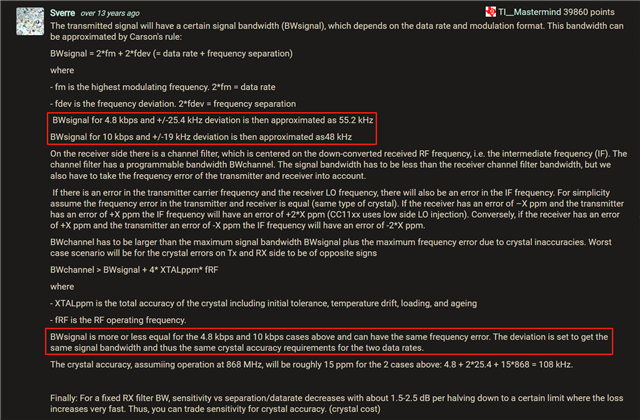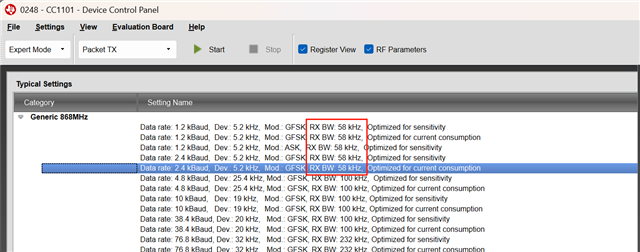Tool/software:
Hi, TI team,
I need to use the 3.85k data rate (to achieve a period duration of 260 µs), which is not included in the typical settings for CC1101 listed in the SmartRF Studio.
I've found a post discussing this issue and gone through it carefully.
Reference Post:

based on Sverre's comments in the post,
"BWsignal for 4.8 kbps and +/-25.4 kHz deviation is then approximated as 55.2 kHz (this may be a typo, it shoud rather be 55.6kHz)
BWsignal for 10 kbps and +/-19 kHz deviation is then approximated as48 kHz "
"BWsignal is more or less equal for the 4.8 kbps and 10 kbps cases above and can have the same frequency error. The deviation is set to get the same signal bandwidth and thus the same crystal accuracy requirements for the two data rates. "
It seems that the deviation for different data rates should make the BWsignal roughly the same, and consequently, the BWchannel(i.e. RX BW) should also be the same for several closely related data rates.

Do I understand this correctly? Are there any groupings or families you use when providing these settings?
If there are such groups
should I set the RX BW for 3.85k data rate to 58k, the same as the 2.4k data rate ? or 102k, as with the 4.8k data rate ?
Additionally, TA12012's reply in the post indicates that the modulation index should always be 0.5 and above to ensure the proper operation of CC1101. and for low data rate, we should go with the high index.

inspired by his guidance, I have explored the different settings for my intended data rate 38.5k and made a comparison table as below:
| Data Rate (kbps) | Deviation (kHz)
|
Modulation Index
|
BWsignal (kHz) | RX BW (BWchannel) (kHz) |
|
1.2 |
5.2 |
8.7 |
11.6 |
58 |
|
2.4 |
5.2 |
4.3 |
12.8 |
58 |
|
3.85 |
5.2 |
2.7 |
14.3 |
58 |
|
3.85 |
25.4 |
13.2 |
54.65 |
102 |
|
3.85 |
22.2 |
11.5 |
48.3 |
102 |
|
4.8 |
25.4 |
10.6 |
55.6 |
102 |
|
10 |
19 |
3.8 |
48 |
102 |
In the row highlighted in blue, I intentionally adujsted the deviation to 22.2 to achive a modulation index of 11.5, which aligns more closely with the index 10.6 of the 4.8k data rate.
Does this approach seem reasonable?
Thank you for your time and insights, I would appreciate any guidance on recommended settings for a 3.85k data rate.
Best regards



